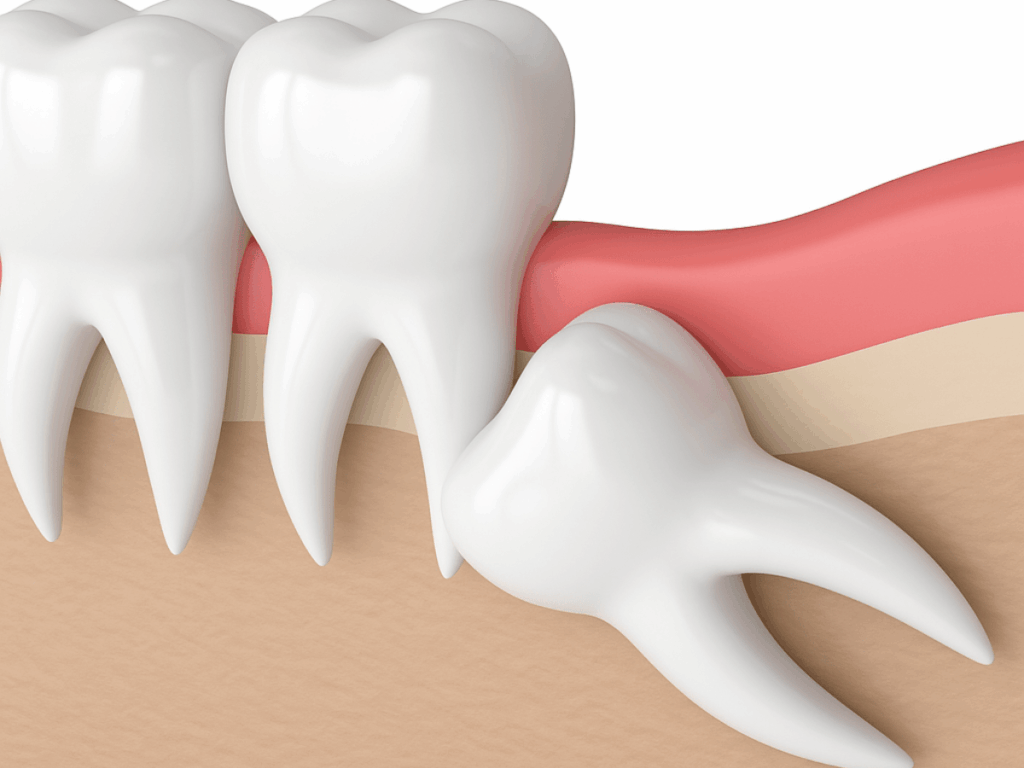You just had your wisdom teeth removed and now the throbbing has kicked in. Even sipping water feels uncomfortable, and all you want to know is how to make the pain stop. The truth is, recovery doesn’t have to be miserable. With the right mix of dentist-approved strategies and a few at-home adjustments, you can ease discomfort, speed up healing, and actually feel human again.
At Elizabeth L. Wakim DDS, we focus on making every step of your recovery as smooth as possible. From advanced extraction techniques that minimize trauma to personalized aftercare instructions designed to reduce swelling and pain, we help patients heal comfortably and confidently.
In this guide, we’ll walk through pain relief for wisdom teeth removal that really works, what to expect in the days after surgery, and when it’s time to call your dentist for extra help.
Why Wisdom Tooth Pain Happens

Every year, about 5 million Americans undergo wisdom tooth extraction, making it one of the most common oral surgery procedures. Wisdom tooth extraction affects more than just the tooth itself. During surgery, the surrounding bone, gum tissue, and nerves are involved, which is why discomfort is so common afterward.
- Inflammation and swelling: Once the tooth is removed, your body sends blood and fluid to the area to begin healing. This natural response creates pressure that can feel sore or throbbing.
- Nerve sensitivity: The nerves around your wisdom teeth are stimulated during extraction, which can leave the area extra sensitive for a few days.
- Healing timeline: For most people, pain peaks within the first 24 to 48 hours and gradually decreases over the next week. Some stiffness or soreness may linger, but it should steadily improve with proper care.
Knowing why pain happens makes it easier to understand which relief methods actually work and when it might be time to call your dentist. Sometimes pain stems from issues beyond wisdom tooth extraction, such as a cracked or damaged tooth. Learn about the common symptoms of a fractured tooth and treatment options to help you recognize when professional care is needed.
Set Yourself Up for a Smoother Recovery: Pre-Surgery Tips
A little preparation before your wisdom teeth removal can make a big difference in how smoothly you recover and how quickly you get back to a normal diet.
1. Talk to Your Dentist About Pain Relief and Home Care

Ask about prescription medications, over-the-counter pain relievers, and how to minimize post operative bleeding. Your dentist will also explain what to expect once the local anesthesia or general anesthesia wears off and provide personalized home care instructions.
2. Stock Up on the Right Supplies

Have ice packs ready to minimize swelling, extra gauze to control post operative bleeding, and a small glass or cup for mixing a warm salt water or saltwater solution for rinsing after the first 24 hours. Prepare a soft food diet with items like yogurt, mashed potatoes, or scrambled eggs so you are not tempted to eat hard or crunchy foods too soon.
3. Plan Meals and Hydration

Eat a balanced meal (if your dentist allows) before surgery to support better healing. Afterward, stick to a soft food diet to reduce irritation to the surgical site and blood vessels around the extraction area. Gradually return to solid foods only when your dentist advises it is safe.
4. Avoid Certain Medications and Habits

Some anti-inflammatory drugs, herbal supplements, or strenuous exercise can increase post operative bleeding or slow recovery. Avoid these unless cleared by your dentist, and never use vigorous rinsing or a sucking motion with straws in the first 24 hours to protect the blood clot in the extraction socket.
5. Arrange for Rest and 
Plan to rest for the first day or two and avoid heavy lifting or strenuous exercise that could increase blood pressure and disrupt healing. Have a friend or family member drive you home after the procedure and help while the sedation wears off.
Being prepared helps reduce inflammation, lowers associated discomfort, and sets you up for better oral health while you heal.
Easing Pain Right After Wisdom Teeth Removal
The days following wisdom teeth removal can feel challenging, but the right care can make all the difference. While full recovery often takes one to two weeks, most people can return to their usual routines within three to five days. Pain usually peaks in the first 24 to 48 hours and then gradually improves over the next few days. Here’s how to manage discomfort effectively and support a smoother recovery.
Immediate Pain Relief (First 24–48 Hours)
Pain and swelling often peak in the first two days after surgery. These steps can help you feel more comfortable:
- Apply cold compresses or ice packs: Place on the outside of your cheek for 15–20 minutes at a time to reduce swelling.
- Control bleeding with gauze or tea bags: Bite gently for 20–30 minutes to help a clot form and stay in place.
- Take pain relievers as directed: Use dentist-recommended NSAIDs such as ibuprofen or acetaminophen within safe limits.
- Rest with your head slightly elevated: Propping up your head helps reduce swelling and pressure.
- Follow your dentist’s instructions closely: Proper wound care supports faster healing and fewer complications.
Pain Relief as You Heal (Day 3 to 7+)
By day three, swelling typically begins to ease, but tenderness is still normal. Continue with these supportive habits:
- Switch from cold to warm compresses: Gentle warmth eases lingering soreness and improves circulation.
- Eat soft, nutrient-rich foods and stay hydrated: Stick to soups, yogurt, or smoothies that are easy on the extraction site.
- Rinse gently with warm saltwater: Helps keep the area clean and lowers bacteria without disturbing the clot.
- Avoid hot, spicy, crunchy, or acidic foods: These can irritate healing tissue and delay recovery.
- Monitor for unusual symptoms: Increasing pain, bad taste, or swelling that worsens should be checked by your dentist promptly.
When Pain Relief Isn’t Enough: Signs You Should Contact Your Dentist
Some level of soreness, swelling, and even slight bleeding is expected after removing wisdom teeth. With proper oral hygiene, a soft food diet, and following all post operative instructions, most discomfort should steadily improve within the first few days.
If pain worsens or returns after you begin to heal, it may indicate a complication that needs prompt attention. Call your dentist as soon as possible if you notice any of the following:
Pain That Gets Worse Instead of Better After 3 Days
Pain should ease as the extraction socket heals. If it intensifies instead, it could point to a painful condition such as dry socket or an infection that requires evaluation.
Severe Swelling or Redness That Spreads
Swelling usually peaks within 24 hours and then begins to minimize. Increasing swelling or redness around the surgical site, jaw, or nearby teeth may signal infection or delayed healing.
Persistent Bleeding or a Bad Taste in Your Mouth
Slight bleeding is normal during the first 24 hours, but excessive bleeding that does not slow down with gauze pads or a persistent foul taste could mean the blood clot has been disturbed in the tooth socket.
Fever, Chills, or Feeling Unwell
A rise in blood pressure, fever, or chills combined with nausea that persists may indicate a spreading infection and needs urgent evaluation by your oral surgery team or dentist.
Difficulty Opening Your Mouth or Swallowing
Trouble opening your jaw, swallowing, or increased tenderness around the tongue or upper jaw can point to significant swelling or a serious infection that should be addressed immediately.
Prompt care not only helps relieve pain but also protects your oral health and prevents further damage to the extraction site and other teeth. Ignoring lingering discomfort can allow small issues to worsen, so it is best to address problems early. Learn more about the reasons you should never ignore a toothache and why timely treatment matters.
Healing Comfortably After Wisdom Teeth Removal
Recovering from wisdom teeth removal does not have to be overwhelming. Managing pain with cold compresses, soft foods, and dentist-approved medication can make a big difference in those first few days. Staying alert to warning signs such as worsening pain, swelling, or unusual bleeding helps you catch potential complications early. Routine follow-ups and diagnostic tools such as dental X-rays also help your dentist monitor healing and ensure no hidden problems are developing beneath the gums.
At Elizabeth L. Wakim DDS, we guide our patients through every step of the healing process with personalized aftercare plans to keep discomfort low and recovery on track.
Call our Pennsylvania office at (724) 558-8222 or use our contact form to schedule a visit. Do not wait until minor discomfort turns into a bigger problem. Reach out today to protect your health and feel confident as you recover.

